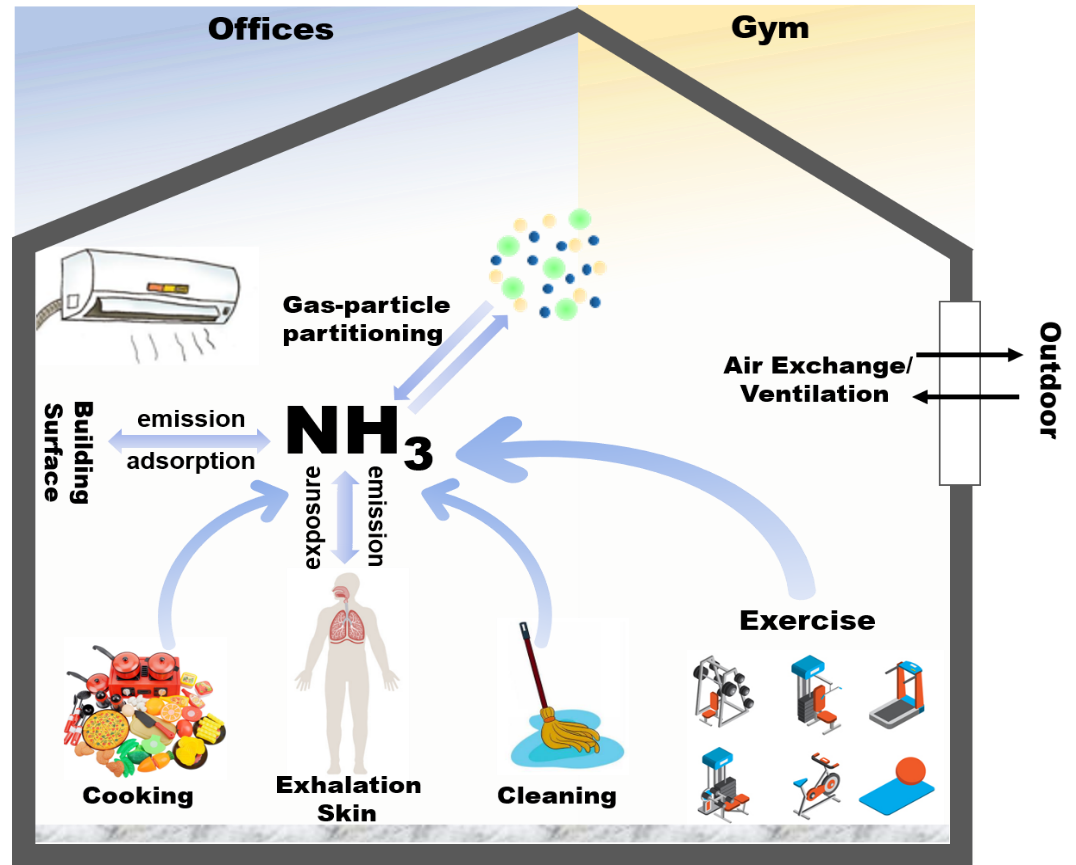Ammonia (NH3), the most important alkaline gaseous in the atmosphere, often shows significantly higher concentrations in occupied indoor environments than outdoors, and poses a potential threat to human health. However, the sources and variations in indoor environment are poorly known. NH3 has a variety of indoor sources such as tobacco smoking, cooking, cleaning, building materials, and human emissions. Measurements of indoor NH3 concentration with high accuracy and time resolution is significant to better understand its role in contributing to secondary inorganic aerosol formation and determine human exposure levels to NH3 in the indoor environment.
Sources and dynamic variations of NH3 in different indoor environments. (Image by LI Junyao)
Professor SUN Yele and his team with the Institute of Atmospheric Physics, Chinese Academy of Sciences, conducted highly time-resolved measurements of NH3 and CO2 in three occupied academic offices and an underground gym in three seasons. They demonstrated the NH3 levels in different seasons and indoor environments and explored the effects of common indoor activities on indoor NH3.
"The temporal variations of NH3 tracked well with CO2 in most indoor environments except for a newly decorated office", said Prof. SUN, "Such good correlations suggested that the variations of indoor NH3 were mainly associated with human activities. However, the office with only one person occupied reached high NH3 mixing ratio due to the strong emission of decoration materials."
They found that the fraction of skin covered by clothing, indoor temperature, building materials and human activities (such as occupancy, opening windows, cooking, cleaning and taking exercise) can strongly affect indoor NH3 mixing ratios. "Increasing temperature will accelerate the release of NH3 from surface reservoir and building materials, therefore, air conditioning plays a key role in regulating indoor NH3 levels." said Prof. SUN.
Prof. SUN said, "Cooking also contribute significantly to indoor NH3 levels. It is very interesting that the NH3 emissions from cooking depend strongly on the types of food." The team found that meat cooking emits the highest NH3 due to the thermal decomposition of amino acids in proteins.
These findings, published in
Building and Environment, highlight the important role of human activities and environmental conditions on indoor NH
3 mixing ratio and the potential threats on human health.
"Next step, we'll investigate NH3-NH4 transformation mechanisms, gas-surface equilibrium mechanisms and NH3-related indoor chemical reactions." Prof. SUN said.
Reference:
Li, J., Xu, W., You, B., and Sun, Y.: Dynamic variations of ammonia in various life spaces and seasons and the influences of human activities, Building and Environment, 212, 108820, https://doi.org/10.1016/j.buildenv.2022.108820, 2022.
Media contact: Ms. LIN Zheng, jennylin@mail.iap.ac.cn

